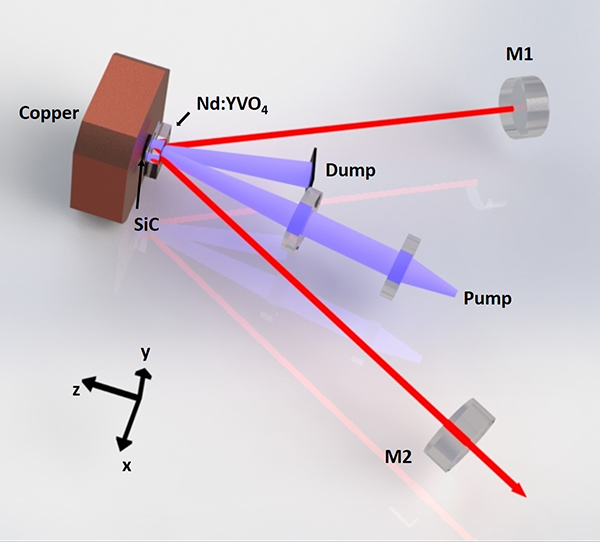Diode-pumped solid-state (DPSS) lasers have made great progress in the past decades. One of the enduring obstacles that DPSS have faced is the restriction from high thermal gradients and aberration under intense pumping conditions. However, with the face cooling configuration of a thin, disk-shaped active medium, the diode-pumped architecture allows building high output power solid-state lasers with excellent spatial beam quality and high conversion efficiency. Since then, thin disk lasers with high power have attracted attention because of their various applications in the material processing industry. Research conducted on high-power thin disk lasers has primarily focused on the Yb:YAG, because it exhibits considerably lower thermal loading factor and broad bandwidth for short pulse output. However, Yb:YAG require a high-pump density to reach the threshold, and are intrinsically sensitive to temperature due to their quasi-three-level nature. The spectroscopic parameters of the Nd-doped materials are superior to those of the Yb-doped materials. Among the Nd doped materials, Nd:YVO4 offers several advantages: a large stimulated emission cross section at 1064 nm, linearly polarized emissions, broad absorption bandwidth, and high absorption cross section at 808 nm pump wavelength, which is particularly advantageous for reducing passes of the pump radiation to achieve efficient absorption. Improvement of absorption efficiency is typically achieved by multi-pass pumping scheme. However, this complicated and expensive multi-pass pumping architecture is not desirable for many applications. Therefore, studying a simple structure of Nd:YVO4 thin disk laser is of great significance for practical applications.
For Nd:YVO4 thin disk laser, low absorption of the pump radiation occurs because the effective absorption path length is twice the thickness of the disk. Improvement of absorption efficiency implies the use of high doped or thick crystals to compensate for the lower absorption. In addition to effective pump absorption, the thermal effects of the crystal must also be considered. In practice, the performance of Nd:YVO4 thin disk laser in terms of maximum output power, beam quality, and efficiency, are often affected by thermal effects due to its strong absorption and moderate thermal conductivity. The thermal lens is a critical factor for resonator design. Moreover, the thermal stress will ultimately induce crystal fracture and the spherical aberration will induce degradation in beam quality and resonator losses.
The research group led by Prof. Xiaoyan Liang from Shanghai Institute of Optics and Fine Mechanics, Chinese Academy of Sciences demonstrated a simple, compact double-pass pumped Nd:YVO4 thin disk laser. The scheme of in-band pumping, undoped end face bonds, and SiC material heat sink were combined to alleviate the thermal effect. The influence of Nd doping concentration and thickness on the continuous-wave performance were experimentally investigated. The related research results are published on High Power Laser Science and Engineering Vol. 8, Issue 1, 2020 (Wei Wang, Di Sun, Xiao Du, et al. High-power operation of double-pass pumped Nd:YVO4 thin disk laser[J]. High Power Laser Science and Engineering, 2020, 8(1): 01000e10).

A simple, compact double-pass pumped Nd:YVO4 thin disk laser
The maximum output power of 17.7 W is achieved by employing a 0.5 at.% doped sample, corresponding to an optical-to-optical efficiency of 46% with respect to the absorbed pump power. At the same time, a numerical analysis of the temperature distribution and thermal lens effect in the laser considering the influence of energy transfer upconversion effect was presented and compared with the experimental results. The effect of the temperature dependence of the thermal conductivity tensor was also taken into account. The numerical simulations were based on the finite-element analysis methods and carried out using the COMSOL software, which matched well with the experimental results. Such a simple and compact dual-pass pumped Nd:YVO4 thin disk laser system can be used to achieve mobile wireless power transmission based on all-solid-state lasers. Consequently, the theoretical model can be employed as a useful tool for the design of the distributed face cooling scheme.
In order to achieve higher laser output power, a heat sink of diamond material can be used to further alleviate the thermal effect of the crystal. In addition, the research on the adjustment-free and movable laser resonator based on Nd:YVO4 thin disk laser is also under study.


